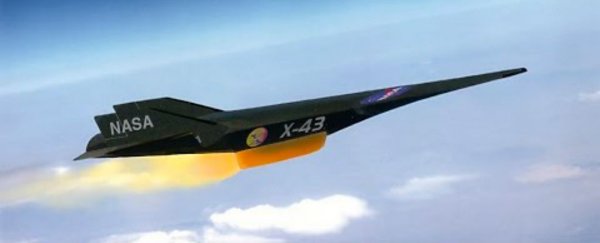Aviation experts from NASA, the US Airforce, and Lockheed Martin have come together in California to announce that hypersonic planes are "inevitable" - meaning we'd better get used to the idea of travelling at more than five times the speed of sound.
If that speed doesn't mean that much to you, how does 4,800 km/h (3,000 mph) sound? Or how about London to New York in 35 minutes, and London to Sydney in 2 hours?
"We're poised on the brink of a new era in air transportation," said David McBride, director of NASA's Armstrong Flight Research Centre, at the recent Forum on American Aeronautics.
McBride counted both hypersonic and supersonic passenger planes as technologies that are well within our grasp, with supersonic being defined as travelling faster than the speed of sound, and hypersonic being five or more times the speed of sound.
"We do need to go faster. There is a market for supersonic flight over land in an efficient manner that can fly without being an annoyance to everyone on the ground," he said.
The forum, which also included Craig Johnston, director of aeronautics strategy and business development at Lockheed Martin; and retired Air Force General, Curtis M. Bedke from the Mitchell Institute for Aerospace Studies, took place at California's Mohave Air and Space Port on October 27.
Five aerospace and military experts discussed how we could finally get this technology off the ground - so to speak - after so many decades of development.
"It is inevitable that hypersonic technologies are going to happen," said Bedke. "What's exciting about aerospace today is that we are in a point here where suddenly, things are happening all across the board in areas that just haven't been happening for quite a while."
Strangely enough, we've actually achieved manned hypersonic flight before - way back in 1967.
American aeronautical engineer William John "Pete" Knight piloted the hypersonic, rocket-powered North American X-15 - a jet that set speed and altitude records for manned aircraft, by cruising at 7,274 km/h (4,520 mph or Mach 6.72) and reaching the edge of space.
But now, almost half a century later, those records have still never been challenged.
Not for a lack of effort, though. Late last year, Airbus patented a hypersonic jet that could fly from London to New York in 1 hour, reaching speeds as high as Mach 4.5 (4.5 times the speed of sound).
And in May this year, a joint US-Australian military project called Hypersonic International Flight Research Experimentation (HIFiRE) passed a crucial test in the Australian desert.
With tests expected to run into 2018, the HiFiRE technology has so far been able to reach an altitude of 278 km (172 miles) at a target speed of Mach 7.5 (7.5 times the speed of sound).
"That's far faster than the 'supersonic' Concorde aircraft ever achieved," Duncan Geere explained for Tech Radar. "At that speed, you could reach anywhere on the planet in a couple of hours."
So what's the hold-up? As Douglas Messier reports for Space.com, Steve Knight from the US Science, Space and Technology Committee pointed out that it still takes the same 4.5 hours or so to fly from New York to Los Angeles today as it did 30 years ago.
With missions to Mars on the horizon, that just doesn't seem right.
The one big problem that NASA, the Air Force, Airbus, and Boeing are all struggling with is sonic boom - the shockwave and "boom" sound created by an aircraft as it hits speeds faster than the speed of sound.
Since Concorde retired its supersonic passenger jet in 2003, all supersonic aircraft have been banned from flying over land in the US because of the sonic booms they produce.
NASA has been designing a passenger jet that could break the sound barrier without producing sonic boom at all, and hope to start test flights could begin as early as 2020. If researchers can figure out how to eliminate, or just quieten, the sonic boom, that ban might be lifted.
The other big problem is something that seems to plague research in every field: no follow-up.
As Lamar Smith, also from the US Science, Space and Technology Committee, said:
"[W]e're going to have to stop the history of fits and starts, of throwing money at a big program, achieving a wild success, and then having no follow-up. Or throwing a lot of money at too big a program, taking too giant a bite, failing miserably, and then deciding hypersonics isn't going anywhere. Neither of those must be allowed to happen in the coming years."
Right on.
With a one-way flight between Sydney and New York taking more than 20 hours right now, we need this badly, and we've got the best aerospace researchers in the world on the case. Bring on the future.
You can watch the whole session at the forum below:

